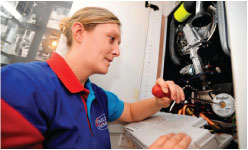As we move into a technological world, electricity has become a big part of our lifestyles, from our televisions at homes to our computers in our workplace. It’s more than likely that you’ve probably been shocked by static electricity before, like when you walk across carpet or when you go to touch a car door, but as electricity becomes a vital part of modern life, we forget just how dangerous electricity can be. According the electrical safety council, during 2011/2012, there were 2,899 fires, 223 injuries and 10 deaths from electricity supply such as wiring, cabling and plugs. These figures emphasise just how important it is to treat electricity with respect.
Children are naturally curious and don’t know the dangers of electricity. With your children growing up in the technological generation, it is vital to educate them so that they understand the dangers of electricity. Of course you don’t want to completely frighten your children, but teaching them the basics about the power of electricity can keep them safe. Here’s a few methods you can use to get your kids more clued up about electrical hazards.
Safety Lessons
Although electricity safety starts in the early years of school, it’s important that you educate them at home as well. Make learning fun by giving your children some fun activities to complete around electrical safety. There are lots of different child friendly YouTube videos on electrical safety as well as interactive games and quizzes available on the internet that they can complete to help them remember important facts.
If your children are slightly older (8 and above) get involved with your children by starting to let them use electrical appliances themselves. Give them the opportunity to show you how they understand the dangers of electricity by letting them, for example, show you how to work a microwave in a safe way. Supervise them and talk them through the steps until they can talk you through the steps themselves. Praise your children to show them how pleased you are that they understand how to be safe around electrical devices and they’ll feel rewarded.
Lead by example
You’re children learn a lot from the way you behave so don’t let your child catch you mistreating electrical objects, as its more than likely that they follow your bad habits. So when you go next go to get your piece of toast out of the toaster with a metal knife, don’t – for your own safety as well as your child’s.
Make sure you don’t leave any electrical appliances unattended or cords draping over surfaces, where small hands and mouths might be able to get hold of. Keep any appliances out of reach and for smaller electrical appliances, like a hairdryer, make sure you store them away or put them in a place out of reach of your children.
Check your appliances
Take the time to take a look at your appliances to see if they are safe. It is sometimes possible to see when your appliances look unsafe, for example if the cords are looking frayed or if there are any burn marks on the sockets. If any of your electrical cords are looking this way, don’t try and ‘patch’ them up as this is only increase the danger for you and your family. If you don’t trust your own judgement, it’s always worth getting in an expert with electrical test equipment to double check your devices and replace them.
Make it clear to your children that electricity is dangerous
If you have very young children that are too young to understand detailed explanations about the dangers of electricity, be clear and use strong, consistent language so they learn to understand that they are not to approach electrical devices because they are dangerous. As they start to get older you can gradually start to begin to give them more detailed explanations as to why electrical appliances are dangerous.
The earlier you start to teach your children about the dangers of electricity, the better educated they will be, reducing the risks of them getting hurt.
Our thanks to Katharine Ogilvie, katherine@fountainpartnership.co.uk;
Fountain Partnership Ltd is registered in England and Wales as company number 7551957

